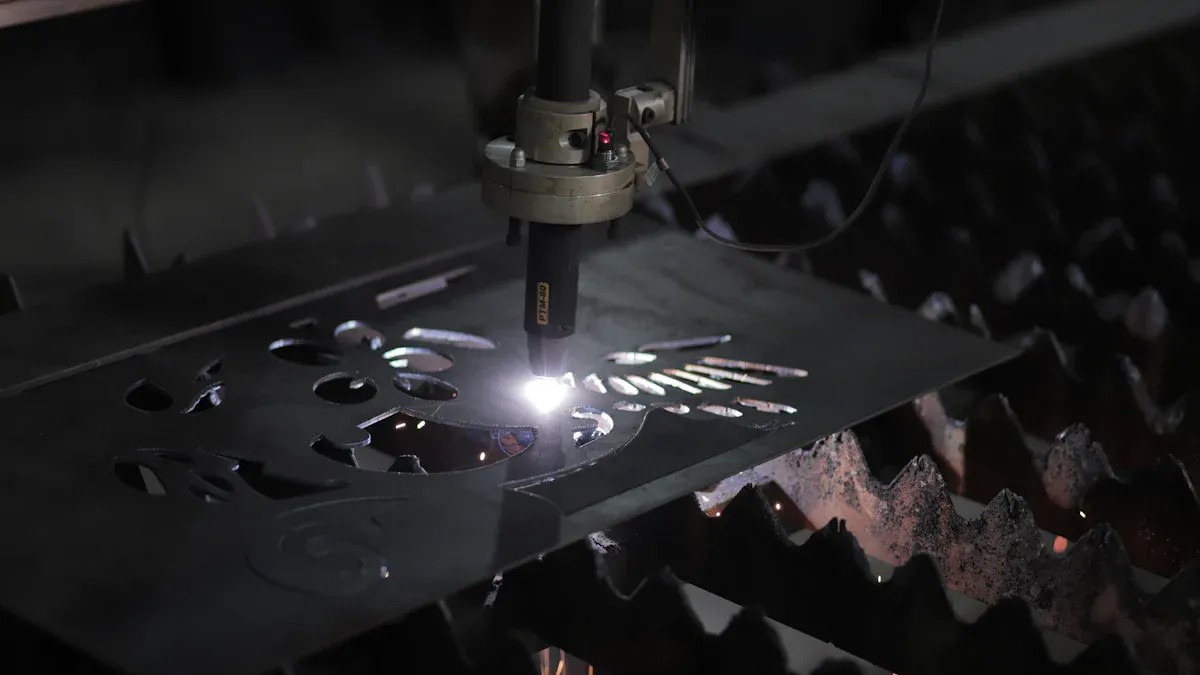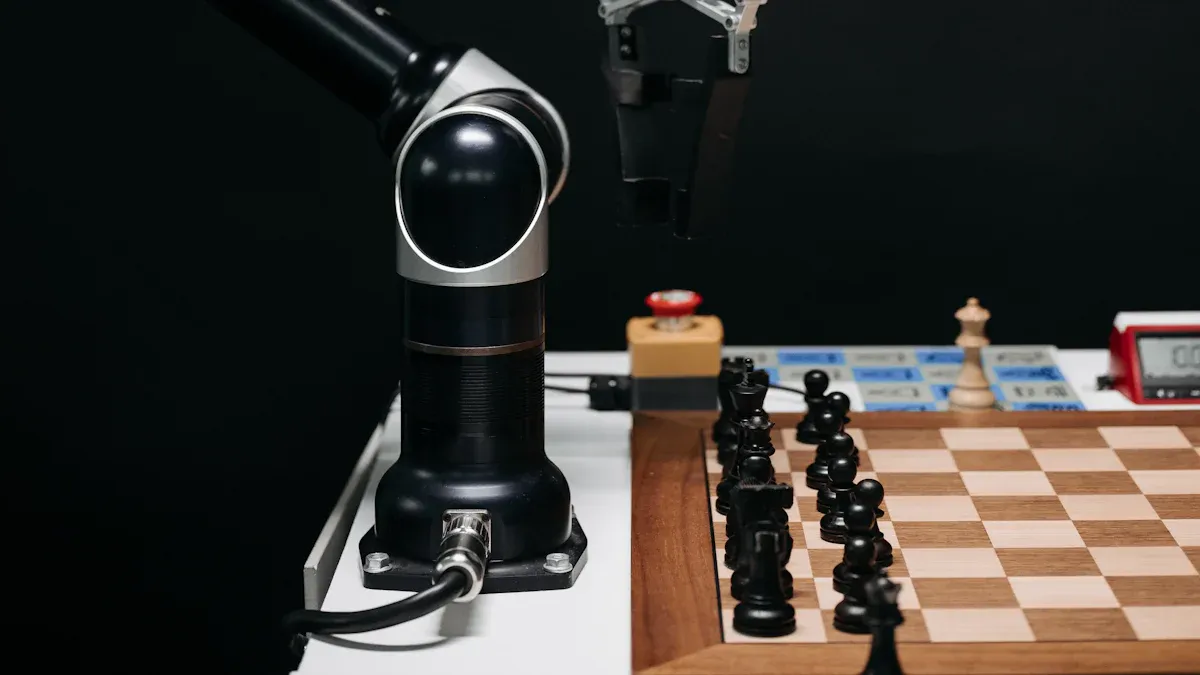Apr.
29, 2025
Contents
Titanium vs Aluminum in Robotics Key Differences in 2025
Titanium vs. Aluminum: Material Properties
Titanium vs. Aluminum: Cost and Manufacturing
Application-Specific Advantages of Titanium vs. Aluminum
Choosing Between Titanium and Aluminum for Robot Arms

When making robot arms, you need to consider the differences in Titanium vs. Aluminum. Both materials offer unique advantages. Titanium is incredibly strong and durable, making it ideal for demanding tasks. On the other hand, aluminum is lightweight and cost-effective, which can help save both money and energy. By comparing Titanium vs. Aluminum, you can make an informed choice that ensures your robot operates efficiently while staying within budget.

Titanium is very strong and great for robot parts. Its Ti-6Al-4V ELI alloy is stronger than most types of aluminum. Titanium bends better, so it doesn’t crack easily.
Titanium’s strength is similar to high-performance metal plates.
Aluminum is not as strong but works for lighter tasks.
If your robot arm lifts heavy things, titanium is the best choice. Aluminum is better for lighter jobs where weight matters more than strength.
Weight is important for robots, especially ones that move around. Titanium and aluminum have different densities, which affect their weight.
| Material | Density |
|---|---|
| Titanium | ~4.5 g/cm³ |
| Aluminum | Lighter than Titanium |
Aluminum is less dense, making it good for lightweight designs. Robots needing mobility or energy savings benefit from aluminum parts. Titanium is heavier but very strong for its weight, making it great for tough jobs.
Titanium lasts longer and handles wear better than aluminum. It works well in tough places with high heat or stress.
Aluminum doesn’t last as long but is fine for regular use. It can bend or scratch more easily under heavy use. For robots in harsh conditions, titanium is the durable option. Aluminum is cheaper and works for easier tasks.
Cost is important when picking titanium or aluminum for robots. Titanium costs more because it’s harder to extract and process. Its strength and durability make it worth the price for tough jobs. Aluminum is cheaper and easier to find. It’s great for lightweight designs or simpler tasks.
If you have a small budget, aluminum is a smart choice. Titanium is better for projects where strength matters more than cost. Choosing the right material helps balance your budget and robot needs.
Titanium and aluminum are different to work with. Titanium is tough and resists heat, making it harder to machine. This takes more time and wears out tools faster. Aluminum is easier to machine, so it’s good for quick prototypes and big projects.
Drilling with robots can be tricky:
Big holes are hard because robot arms bend.
Keeping accuracy within ±0.5 mm is challenging.
Drilling force can make tools slip and ruin parts.
For precise machining, aluminum is simpler to use. Titanium needs special tools but works well in tough conditions.
Both titanium and aluminum work with 3D printing, but they’re different. Titanium is strong and durable, perfect for high-performance parts. Aluminum is light and cheap, great for mobile robots.
| Material | Process | Strength | Stretch | Hardness |
|---|---|---|---|---|
| Titanium (Ti 6Al-4V) | DMLS | 172 ksi | 10% | 40 HRB |
| Aluminum (AlSi10Mg) | DMLS | 35 ksi | 10% | 45 HRB |
| Aluminum 6061-T651 | CNC | 40 ksi | 17% | 95 HBW |
| Aluminum 7075-T651 | CNC | 83 ksi | 11% | 85 HBW |
| Titanium (Grade 5 Ti 6Al-4V) | CNC | 138 ksi | 14% | 35 HRC |
For strong and precise parts, titanium with DMLS is excellent. Aluminum is better for light and budget-friendly designs.
Robots doing tough jobs need strong materials. Titanium is great for these tasks. It is very strong and doesn’t bend easily. This makes it perfect for robot arms lifting heavy things or working under pressure. Alloys like Ti-6Al-4V stay strong even under stress.
Aluminum is not as strong but works well for lighter tasks. It’s best for robots that need to move fast and don’t lift heavy loads. If your robot has easier jobs, aluminum is a cheaper and effective choice.
Weight matters a lot for moving robots. Aluminum is light, making it perfect for designs needing less weight. Its lightness helps robots save energy, move faster, and use less power. This is why aluminum is great for drones and self-driving vehicles.
Titanium is heavier but much stronger. You can use less of it to get the same strength. This makes it good for robots needing both strength and mobility. For example, in space robots, titanium parts are strong and save weight at the same time.
Robots often face water, chemicals, or heat. Both titanium and aluminum resist rust, but titanium is better in tough places. It works well in saltwater and medical tools because it doesn’t react easily.
Aluminum also resists rust due to its oxide layer. But it can weaken in some chemical environments. Still, aluminum is a good choice for most normal uses, especially when cost and weight are important.
Tip: Use titanium for robots in harsh conditions. For easier jobs, aluminum is a lighter and cheaper option.
When picking between titanium and aluminum for robot arms, think about performance, cost, and your project needs. Titanium is super strong and lasts a long time, making it great for tough jobs. Aluminum is lighter and cheaper, which is better for designs needing mobility and saving money.
Here’s how they compare in machining and maintenance:
| Factor | Titanium | Aluminum |
|---|---|---|
| Machining Processes | Wears tools faster, costs more to machine | Easier to work with, costs less to fabricate |
| Durability and Lifespan | Lasts longer, needs less maintenance | Wears out faster, needs more replacements |
Though titanium costs more upfront, it lasts longer. For example, studies show titanium parts need 50% fewer replacements than aluminum. This makes titanium a smart pick for long-term use.
Pick titanium for robot arms doing heavy or tough tasks. Special titanium alloys, like Ti-based bulk metallic glasses (BMGs), are strong, flexible, and resist wear. These features are perfect for robots in factories or space. Titanium also handles heat well and doesn’t weaken under pressure.
If your robot arm lifts heavy things or works in harsh places, titanium is the best choice. It has a compressive strength over 1000 MPa and fatigue strength above 500 MPa. These numbers mean it’s safe and reliable for important jobs.
Choose aluminum for lightweight and budget-friendly designs. Its low weight helps robot arms move easily and use less energy. For instance, aluminum arms can cut design time by 40% and achieve precise movements within 0.05mm.
Aluminum is also simpler to machine, which saves money and speeds up production. This makes it great for prototypes or mass production. While aluminum doesn’t last as long as titanium, it’s a good option when cost and weight matter more than durability.
Tip: Use aluminum for robots that need to move a lot or when saving energy and money is important.
Titanium and aluminum are useful for robot arm parts. Titanium is very strong and lasts a long time. It’s great for tough jobs. Aluminum is light and cheaper, making it good for designs needing less weight.
Key Insight: Pick titanium for hard tasks. Choose aluminum for robots that move a lot or save energy.
Think about cost, environment, and how the robot will work. Knowing these things helps your robot work well and stay reliable.
Titanium is very strong and lasts a long time. It works well in tough places and handles heavy loads safely. If your robot faces hard tasks, titanium is the best choice.
Aluminum is light, so it’s great for saving energy. It helps robots move easily and costs less to make. Aluminum is also simple to shape, making it good for cheaper projects.
Yes, robots can use both materials together. Titanium is great for strong parts, while aluminum is good for lighter ones. Using both saves money and keeps the robot strong and light.
Titanium is worth it for robots needing strength and durability. It lasts longer and needs fewer repairs, saving money over time. For important jobs, titanium is a smart choice.
Both work for 3D printing. Titanium is strong and tough, perfect for hard jobs. Aluminum is lighter and cheaper, great for moving robots or test designs.
Navigation
Navigation
Contact Us
Tel: +86 13417419143
E-mail: [email protected]
Add:
2nd Floor, Building 7, 156 High Tech Industrial Park, Fuyuan 1st Road, Zhancheng Community, Fuhai Street, Baoan District, Shenzhen City, China.